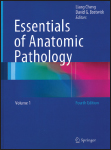Translate this page into:
Essentials of Anatomic Pathology
Corresponding Author:
Sanjay A Pai
Department of Pathology, Columbia Asia Referral Hospital, Malleswaram, Bengaluru, Karnataka
India
sanjayapai@gmail.com
| How to cite this article: Pai SA. Essentials of Anatomic Pathology. Natl Med J India 2019;32:55 |


Essentials of Anatomic Pathology. Liang Cheng, David G. Bostwick (eds). Springer, Fourth edition, 2016. Two volumes, 2109pp, price not mentioned. ISBN 978-3-319-23379-6.
Surgical pathology has its Bible—Rosai and Ackerman’ s textbook—as well as at least two other very good tomes (Sternberg’s and Silverberg’s) on the subject. What could this text offer that the others could not? I wondered, given that I had not seen the earlier editions.
Considerable amounts, I soon discovered. To be sure, Cheng and Bostwick’s text is not meant to be a substitute for any of the books above, but an additional text. It was, I discovered, quite useful in daily practice during the surgical pathology sign out. It is in two volumes; the first largely deals with general aspects of anatomical pathology, while the second volume is devoted to systemic pathology.
The strength of the book is in volume 1, which focuses on the general aspects of surgical pathology and includes topics that are not covered in other texts. The chapter on immunohistochemistry is excellent while the one on immunohistochemistry in metastases of unknown origin is invaluable when you are faced with a differential diagnostic problem. The chapters on transplant pathology and on microbiology for the surgical pathologist are welcome and provide a good overview of the subjects. Transplant pathology, of course, is usually dealt with by specialist pathologists, but microbiology is of importance to every general surgical pathologist and is often a bugbear (pun unintended). Quality and biomedical informatics are the current buzzwords and they are covered, albeit in brief. Generous chapters on molecular pathology, genetics, cytopathology (gynaecology as well as non-gynaecology/fineneedle aspiration cytology), autopsy and on electron microscopy mean that this book would also be of use to the postgraduate student preparing for examinations. Genetics, however, is a misfit in a book on anatomical pathology while autopsy too, probably does not really belong here. Instead, one would have expected a chapter on frozen sections and, perhaps, on the setting up of an anatomical pathology laboratory and on immunofluorescence. While special stains are of considerably lesser importance than they were, about a quarter of a century ago, they are not entirely unimportant and readers would have benefited from some pages on the subject. Medical kidney biopsies, for instance, are heavily dependent on special stains and immunofluorescence.
Volume 2 covers the field reasonably adequately but there are many misses. Of course, this is only to be expected as the volume is about 1080 pages long (in addition to about 350 pages of systemic pathology in volume 1 and is inadequate for the overwhelming amount of information in the field. The colour images, with a rare exception, are of excellent quality. The chapter on cardiac pathology, in particular, has outstanding images. The references include some from 2016 (quite remarkable for a book published in the same year).
What are the drawbacks of the book? There is some unevenness in the sizes of the chapters. For example, lymph nodes, the Waterloo of most pathologists, are dealt with in about 40 pages, but as many as 20 pages are devoted to the Organum plenum mysterii, the spleen, an organ that is uncommon in a surgical pathology practice. Most chapters present facts in bullet form— a style that I am uncomfortable with—rather than in proper and complete sentences. I am certain that there are many readers who advocate such a ‘PowerPoint’ approach, but the use of standard text style would have made the chapters easier to read and would have resulted in more text (and thereby, additional information) in the same space.
Fulltext Views
2,034
PDF downloads
2,031




